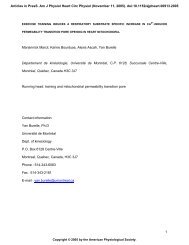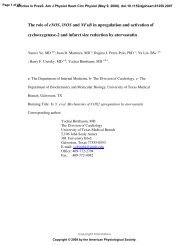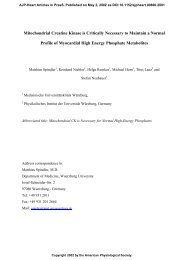Overexpression of 1B-adrenergic receptor induces left ventricular ...
Overexpression of 1B-adrenergic receptor induces left ventricular ...
Overexpression of 1B-adrenergic receptor induces left ventricular ...
Create successful ePaper yourself
Turn your PDF publications into a flip-book with our unique Google optimized e-Paper software.
ine in mouse LV muscle strips. It is possible that the<br />
frequency dependence <strong>of</strong> the inotropic response in this<br />
system may explain their different findings.<br />
In the present transgenic model, the overexpression<br />
<strong>of</strong> a wild-type <strong>1B</strong>-AR led to a <strong>receptor</strong>-mediated decrease<br />
in contractile function. Both contraction and<br />
relaxation phases were affected (Tables 1 and 2). These<br />
results indicate that basal level LV function is severely<br />
impaired in transgenic hearts. A causal relationship<br />
between depressed LV function and <strong>1B</strong>-AR overexpression<br />
is supported by the reversion <strong>of</strong> the contractile<br />
dysfunction by prazosin treatment. We therefore postulate<br />
that the chronic activation <strong>of</strong> <strong>1B</strong>-AR signaling<br />
creates a heart with depressed basal level contractile<br />
functions.<br />
Using different experimental approaches, the anesthetized<br />
closed-chest mouse and the working-heart<br />
perfusion, we observed the same direction <strong>of</strong> functional<br />
changes in the transgenic hearts. This was further<br />
corroborated by the reduced cell shortening in isolated<br />
myocytes from transgenic hearts. The relative decrease<br />
in the rates <strong>of</strong> LV contraction and relaxation were quite<br />
similar in both systems, ranging between 32 and 42%.<br />
The actual values for the rates <strong>of</strong> pressure development<br />
were higher when measured in the closed-chest mouse.<br />
These differences in cardiac performance between the<br />
two preparations are due in part to the higher viscosity<br />
<strong>of</strong> blood and the closed pericardium. It has been shown<br />
previously that comparable rates are obtained when<br />
measuring peak LV dP/dt in the perfused preparation<br />
using the instrumentation <strong>of</strong> the closed-chest model<br />
(31). Similarly, in rat hearts, the rates observed vary<br />
considerably between Langendorff and closed-chest<br />
preparations (24, 27).<br />
With the use <strong>of</strong> an open-chest methodology, contractile<br />
performance has been studied in the transgenic line<br />
Tg43 (1). There, no significant differences in basal level<br />
LVP and dP/dt and dP/dt were reported, although<br />
the values for dP/dt were lower in transgenics after<br />
isoproterenol stimulation. The reason for these differences<br />
to our data is unclear. Methodological approaches,<br />
e.g., open chest vs. closed chest, may account<br />
in part for the observed differences. A recent comparison<br />
<strong>of</strong> myocardial function showed that the type <strong>of</strong><br />
preparation can indeed influence indexes <strong>of</strong> <strong>ventricular</strong><br />
function (20). Also, in the open-chest measurements,<br />
transgenic heart rate was significantly reduced, which<br />
might directly influence contractility and relaxation. It<br />
is also possible that strain differences may affect the<br />
resulting cardiac phenotype.<br />
The reduced amplitude <strong>of</strong> Ca 2 transients in electrically<br />
stimulated, isolated cardiomyocytes indicates that<br />
Ca 2 homeostasis is altered in the transgenic hearts.<br />
This is most likely the basis for the depression <strong>of</strong><br />
baseline LV contractile function. The mechanism by<br />
which <strong>1B</strong>-AR overexpression negatively affects Ca 2<br />
transients is unclear. Stimulation <strong>of</strong> 1-AR is linked to<br />
the activation <strong>of</strong> phospholipase C and the generation <strong>of</strong><br />
the second messengers, diacylglycerol and inositol 1,4,5trisphosphate,<br />
which activate PKC and trigger Ca 2<br />
influx from the sarcoplasmic reticulum, respectively.<br />
LV DYSFUNCTION IN CARDIAC <strong>1B</strong>-AR OVEREXPRESSION<br />
H1347<br />
Previous analyses <strong>of</strong> line Tg43 have demonstrated an<br />
elevated level <strong>of</strong> diacylglycerol in myocardial extracts<br />
(1). Studies on isolated neonatal rat cardiomyocytes<br />
demonstrated an 1-AR-dependent increase <strong>of</strong> L-type<br />
Ca 2 currents (28), although the mRNA for the 1subunit<br />
<strong>of</strong> the channel is downregulated after prolonged<br />
exposure to phenylephrine (33). In adult cells,<br />
however, L-type Ca 2 channels were negatively modulated,<br />
potentially reflecting a difference in G protein<br />
coupling at the two developmental stages (8, 29). In<br />
isolated rat hearts, 1-AR stimulation resulted in a<br />
decrease <strong>of</strong> tissue cAMP levels (30). This may exert a<br />
negative effect on L-type Ca 2 channels that are stimulated<br />
by cAMP (42) and could potentially contribute to<br />
the decrease <strong>of</strong> contractile function in the <strong>1B</strong>-AR<br />
overexpressors.<br />
Alternatively, one could speculate that the overexpression<br />
<strong>of</strong> <strong>1B</strong>-AR uncovers a functional interaction between<br />
the 1-AR and the -AR system. It is conceivable<br />
that various <strong>adrenergic</strong> inputs are integrated within<br />
the cardiomycyte, which requires a molecular communication<br />
between the <strong>receptor</strong>s. Evidence for the contribution<br />
<strong>of</strong> both 1-AR and -AR to the inotropic response,<br />
as well as to the activity <strong>of</strong> ion channels, has been<br />
presented (8, 35, 36, 41). Similarly, the activity <strong>of</strong> other<br />
<strong>receptor</strong>s acting in concert with the <strong>adrenergic</strong> system<br />
can be expected to modulate AR activity, an interaction<br />
that has been demonstrated for the -opioid <strong>receptor</strong>s<br />
(37). The hypothesis <strong>of</strong> molecular cross-talk between<br />
AR is further supported by the finding that the -AR<br />
high-affinity binding site for agonist is lost in <strong>1B</strong>-AR<br />
transgenics, indicating functional uncoupling <strong>of</strong> -AR<br />
at the basal level (I. Lemire, H. Rindt, and T. E. Hebert,<br />
unpublished data). Such a mechanism could also explain<br />
the lower basal level contractile function observed<br />
in transgenic hearts both in the intact animal<br />
and the perfusion preparation. Interestingly, only<br />
chronic, but not acute, prazosin treatment restored<br />
contractile parameters. This suggests that the overexpression<br />
<strong>of</strong> <strong>1B</strong>-AR may alter the molecular cross talk<br />
between 1-AR and -AR in such a manner that a<br />
normal communication cannot be regained within the<br />
time frame <strong>of</strong> antagonist perfusion (minutes) but requires<br />
long-term treatment (hours to days). Prazosin is<br />
not a highly specific 1-AR antagonist but can also<br />
block the activity <strong>of</strong> 2-AR (18). This might result in an<br />
increase <strong>of</strong> norepinephrine release from presynaptic<br />
junctions that could potentially lead to the stimulation<br />
<strong>of</strong> cardiac contractility, thereby masking the effects <strong>of</strong><br />
1-AR blockade in the transgenics. However, in control<br />
(nontransgenic) animals, prazosin did not increase<br />
contractile functions, indicating that potential 2-AR<br />
effects do not play a discernible role in our perfusion<br />
protocol. Therefore, the observed recovery <strong>of</strong> contractility<br />
in the transgenic hearts after prazosin treatment is<br />
most likely due to the blockade <strong>of</strong> the overexpressed<br />
<strong>1B</strong>-AR.<br />
The stimulation <strong>of</strong> -AR with isoproterenol essentially<br />
restored contractility to control values, suggesting<br />
that the maximal inotropic response <strong>of</strong> the transgenic<br />
hearts was not affected. Similar results were<br />
Downloaded from<br />
http://ajpheart.physiology.org/<br />
by guest on June 28, 2013






